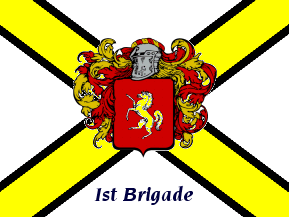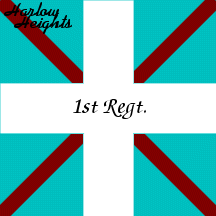Caledonian National Guard
The army of the Kingdom of Caledon is a small force dedicated to defending
the territorial integrity of the kingdom, and is known as the National Guard.
As such, it possesses no weapons that are overtly offensive in nature. The
Caledonian government has also publically rejected the development and/or
use of chemical, biological, or nuclear weapons, citing them as "offensive,
in both senses of the term." In fact, all of the Guard's original
equipment was captured during the country's liberation from the Movement
for a Communist Zartania (MCZ) forces. The MCZ, in turn, obtained most
of the equipment from the former Thistland when they succeeded in subverting
that government. Below you will find a listing of all of the National
Guard's current subordinate units and equipment, as well as information about
some of its personnel, missions, and flags. The National Guard is commanded
by Lieutenant General Lord Andrew Murray, with its headquarters located in
the city of Glascho northeast of the capital.
FLAGS
The National Guard has three types of flags that are used. These
flags are the Guard flag, the King's colors, and the regimental colors.
The Caledonian National Guard flag has a green field with the national flag
in the canton. In the fly of the flag is the Guard badge topped by
a gold royal crown. The Guard badge itself features the blue and white
national thistle badge surmounting two crossed swords. The Guard flag
is flown at military garrisons and facilities belonging to the National Guard,
but is not carried by units in the field. It is simply the National
Guard version of the national flag. The King's colors are the national
flag as carried by military units in the field. Each unit of battalion
size and above is authorized to carry the King's colors (the national flag
in proportions 3:4) defaced by the unit's badge and designation at the center
of the cross. While the King's colors are no longer carried into combat,
they are still used for parade, and are flown along with the Guard flag at
the specific unit's garrison. The regimental colors are a holdover
from a by-gone era when the Caledonian army carried its colors into combat.
At that time, the army was based around its various regiments as the
basic fighting unit. As such, each regiment in the army carried its
own distinctive flag in addition to the King's colors so that the field commander
could see the locations of his forces. While such flags are no longer
carried into combat, the regiment color lives in the National Guard as a
ceremonial flag bestowed only upon regiment's in His Majesty's service. Each
regimental color is square, a features various background and cross colors,
with the unit designation in the center and battle honors on the flag's field.
Regimental colors are only used during parade or inspection.
 (1:2)
(1:2)
Caledonian National Guard flag, est. 301AP
 (3:4)
(3:4)
Caledonian King's colors (example), pattern est. 301AP
 (1:1)
(1:1)
Caledonian Regimental colors (example), pattern est. 124AP
UNITS
The Caledonian National Guard currently is composed of three divisions,
all of which contain infantry, armor, artillery, and other subordinates,
and one strategic reserve regiment. The equipment for the divisions
was captured from the MCZ during the liberation in 301AP. However,
the Caledonian defense industry is currently engaged in the design and production
of new armor, artillery, and other equipment in order to replace the aging
Thistlandic pieces. Because of the kingdom's insistance on non-offensive
weapons, the National Guard has only three armor battalions (one subordinate
to each division), no self-propelled artillery, and no armored personnel
carriers. The backbone of the Caledonian military is its "straight-leg"
infantry, towed artillery, and mortars. Unlike most armies across Vexillium,
the National Guard has no helicopter or fixed-wing air assets, either for
attack or transport. The Royal Caledonian Air Force is the only branch
of the armed forces authorized to operate aircraft, and is therefore tasked
with provided helicopter transport to the National Guard in time of war.
Also because of the kingdom's defensive stance, all National Guard
units at the company level and above are consistantly at half-strength during
peacetime, each company being composed of one active duty platoon and one
reserve platoon. Reservists drill one weekend every two months in order
to maintain efficiency in their combat arms. The National Guard, both
active and reserve, is completely volunteer, with most soldiers enlisting
for four- to six-year tours, while officers are career. Women are allowed
to join the Guard, but may only serve in non-combat units at present.
Below you'll find a list of the current order of battle of the Caledonian
National Guard, as well as major unit commanders and equipment.
National Guard - Lt. Gen. Lord Andrew Murray
1st Division - Maj. Gen. Sir William MacNeil
1st Brigade
1st Regiment
1st Infantry
Battalion
#1 Infantry Company
#2 Infantry Company
#3 Infantry Company
Mortar Battery
(6 x 78-mm mortars)
2nd Infantry Battalion
3rd Infantry Battalion
1st Mortar Battalion
(18 x 130-mm mortars)
2nd Mortar Battalion
(18 x 130-mm mortars)
1st Engineer Battalion
1st Signals Battalion
1st Medical Platoon
2nd Regiment
1st Infantry
Battalion
2nd Infantry Battalion
3rd Infantry Battalion
1st Mortar Battalion
(18 x 130-mm mortars)
2nd Mortar Battalion
(18 x 130-mm mortars)
1st Engineer Battalion
1st Signals Battalion
1st Medical Platoon
1st Artillery Battalion (18 x 135-mm towed gun/howitzers)
2nd Artillery Battalion (18 x 135-mm towed gun/howitzers)
2nd Brigade
3rd Regiment
1st Infantry
Battalion
2nd Infantry Battalion
3rd Infantry Battalion
1st Mortar Battalion
(18 x 130-mm mortars)
2nd Mortar Battalion
(18 x 130-mm mortars)
1st Engineer Battalion
1st Signals Battalion
1st Medical Platoon
4th Regiment
1st Infantry
Battalion
2nd Infantry Battalion
3rd Infantry Battalion
1st Mortar Battalion
(18 x 130-mm mortars)
2nd Mortar Battalion
(18 x 130-mm mortars)
1st Engineer Battalion
1st Signals Battalion
1st Medical Platoon
1st Artillery Battalion (18 x 135-mm towed gun/howitzers)
2nd Artillery Battalion (18 x 135-mm towed gun/howitzers)
1st Armor Battalion
(24 x Type 293 medium tanks)
2nd Division - Maj. Gen. Edward Scott
3rd Brigade
5th Regiment
1st Infantry
Battalion
2nd Infantry Battalion
3rd Infantry Battalion
1st Mortar Battalion
(18 x 130-mm mortars)
2nd Mortar Battalion
(18 x 130-mm mortars)
1st Engineer Battalion
1st Signals Battalion
1st Medical Platoon
6th Regiment
1st Infantry
Battalion
2nd Infantry Battalion
3rd Infantry Battalion
1st Mortar Battalion
(18 x 130-mm mortars)
2nd Mortar Battalion
(18 x 130-mm mortars)
1st Engineer Battalion
1st Signals Battalion
1st Medical Platoon
1st Artillery Battalion (18 x 135-mm towed gun/howitzers)
2nd Artillery Battalion (18 x 135-mm towed gun/howitzers)
4th Brigade
7th Regiment
1st Infantry
Battalion
2nd Infantry Battalion
3rd Infantry Battalion
1st Mortar Battalion
(18 x 130-mm mortars)
2nd Mortar Battalion
(18 x 130-mm mortars)
1st Engineer Battalion
1st Signals Battalion
1st Medical Platoon
8th Regiment
1st Infantry
Battalion
2nd Infantry Battalion
3rd Infantry Battalion
1st Mortar Battalion
(18 x 130-mm mortars)
2nd Mortar Battalion
(18 x 130-mm mortars)
1st Engineer Battalion
1st Signals Battalion
1st Medical Platoon
1st Artillery Battalion (18 x 135-mm towed gun/howitzers)
2nd Artillery Battalion (18 x 135-mm towed gun/howitzers)
1st Armor Battalion
(24 x Type 293 medium tanks)
3rd Division - Maj. Gen. George Herries
5th Brigade
9th Regiment
1st Infantry
Battalion
2nd Infantry Battalion
3rd Infantry Battalion
1st Mortar Battalion
(18 x 130-mm mortars)
2nd Mortar Battalion
(18 x 130-mm mortars)
1st Engineer Battalion
1st Signals Battalion
1st Medical Platoon
10th Regiment
1st Infantry
Battalion
2nd Infantry Battalion
3rd Infantry Battalion
1st Mortar Battalion
(18 x 130-mm mortars)
2nd Mortar Battalion
(18 x 130-mm mortars)
1st Engineer Battalion
1st Signals Battalion
1st Medical Platoon
1st Artillery Battalion (18 x 135-mm towed gun/howitzers)
2nd Artillery Battalion (18 x 135-mm towed gun/howitzers)
6th Brigade
11th Regiment
1st Infantry
Battalion
2nd Infantry Battalion
3rd Infantry Battalion
1st Mortar Battalion
(18 x 130-mm mortars)
2nd Mortar Battalion
(18 x 130-mm mortars)
1st Engineer Battalion
1st Signals Battalion
1st Medical Platoon
12th Regiment
1st Infantry
Battalion
2nd Infantry Battalion
3rd Infantry Battalion
1st Mortar Battalion
(18 x 130-mm mortars)
2nd Mortar Battalion
(18 x 130-mm mortars)
1st Engineer Battalion
1st Signals Battalion
1st Medical Platoon
1st Artillery Battalion (18 x 135-mm towed gun/howitzers)
2nd Artillery Battalion (18 x 135-mm towed gun/howitzers)
1st Armor Battalion
(24 x Type 293 medium tanks)
Strategic Reserve Regiment - Col. Alexander
MacDonald
1st Armor Battalion (21 x Type 291 medium tanks)
2nd Armor Battalion (21 x Type 293 medium tanks)
1st Artillery Battalion (18 x 135-mm towed gun/howitzers)
2nd Artillery Battalion (18 x 150-mm towed howitzers)
1st Transportation Battalion (100 x cargo trucks)
Last updated August 4, 304AP.
©2004 Randy
Young
 (1:2)
(1:2)  (1:2)
(1:2)  (3:4)
(3:4)  (1:1)
(1:1)